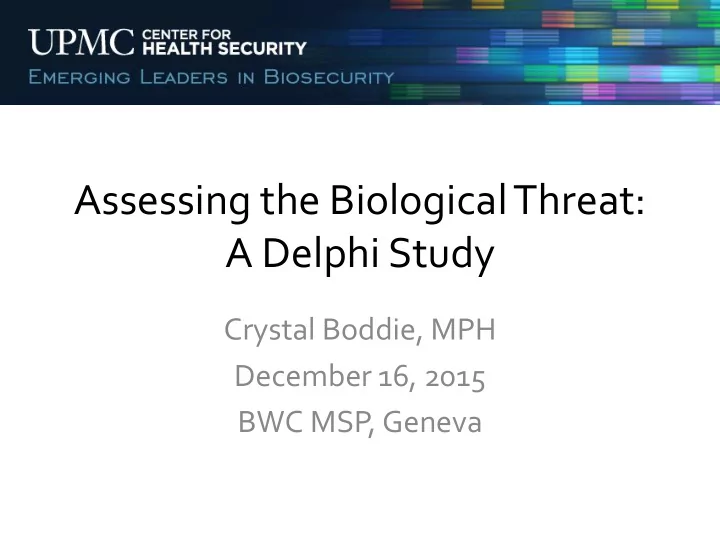

Assessing the Biological Threat: A Delphi Study Crystal Boddie, MPH December 16, 2015 BWC MSP, Geneva
Assessing the Bioweapons Threat • In assessing the threat posed by biological weapons use we often rely on expert opinion – There are few historical examples – Intelligence information is limited • We were interested in assessing how US experts define the threat – We conducted a modified Delphi study – And found that there is large disagreement among US experts about the threat
3
About the Study • Modified Delphi Study – 59 experts at the nexus of biology and security • In biological science, biodefense, biosecurity, biosafety, national security, public health, veterinary medicine, nonproliferation, defense, counterterrorism, international security policy – 2 Rounds of a Delphi Survey • Focused on obtaining collective expert opinion, but avoiding “groupthink,” • Preserves the anonymity of participant inputs • Iterated response and feedback • Statistical aggregation of expert judgments
Likelihood of a large-scale biological weapons attack to occur within the next 10 years
Most and Least Likely Actors • Wide range of opinions, with some significant findings: – State bioweapons use thought to be significantly less likely than non-state or terrorist use (p<0.001) • Particularly overt use by a state actor – Religious extremist use was thought to be most likely, but not significantly more likely than other non-state actors • Others included right and left wing violent non-state actors, disgruntled individuals
Likelihood that a biological agent will be used as a weapon in the next 10 years 10 9 Likelihood of agent use in a biological attack 8 7 6 5 4 3 2 1 0 Non spore- Spore-forming Viruses Biological toxins Prions Fungi Synthetic forming bacteria bacteria pathogens
Percentage Likelihood of Actionable Intelligence Warning of a Biological Attack 11 10 9 8 Number of Responses 7 6 5 4 3 2 1 0 0 5 10 15 20 25 30 35 40 45 50 55 60 65 70 75 Likelihood of Intelligence Warning (%)
Threat Characterization Research • Additional Delphi Data focused on expert judgment about biological threat characterization research • Is there a “red line” for research? – A majority of Experts said yes (51/59), but few defined the “red line” • We are analyzing other questions on threat characterization
Thank You Acknowledgements • Co-Authors: Matthew Watson and Gigi Kwik Gronvall (UPMC Center for Health Security) and Gary Ackerman (University of Maryland START Center) • Support from the US Department of Homeland Security
Recommend
More recommend